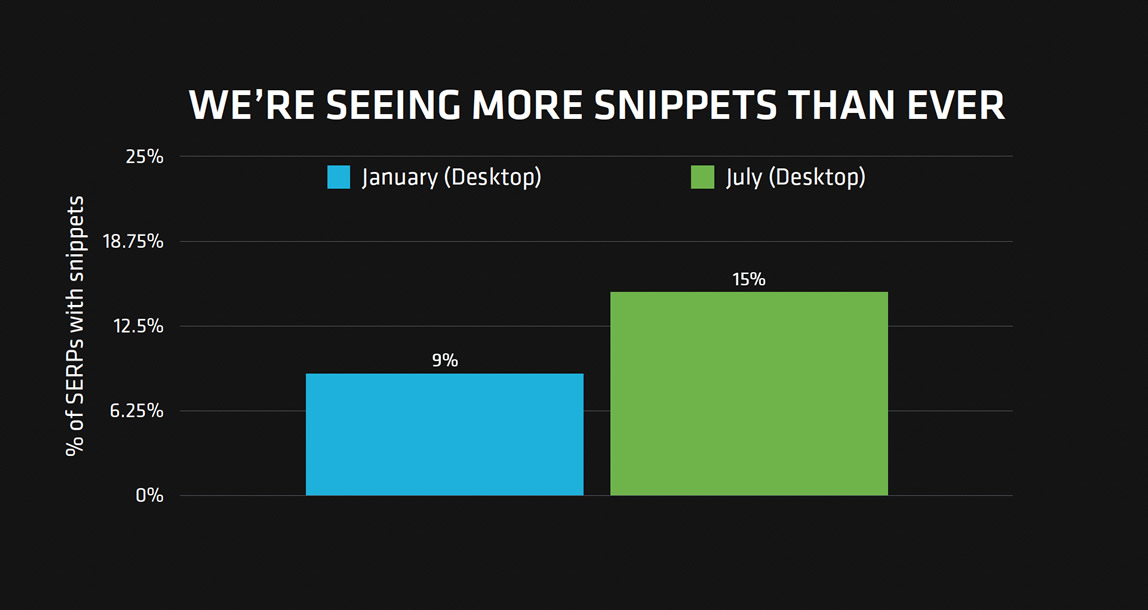We explore how our most favourite SERP feature is fuelling voice search.
What is the hottest SEO topic on everyone’s lips right now? It’s voice search, and it’s no surprise.
According to Timothy Tuttle of MindMeld, in 2015, voice search rose from a statistical zero to make up 10 percent of all global searches. That’s around 50 billion searches each month.
What's the latest trend in SEO?
Voice search is burning up the runway. (This is not a photo of Timothy Tuttle.)
In light of this rising search trend, the SEO industry is busy strategizing ways to stay on top of the SERPs.
And thankfully, we’ve already had our eye on a major component of voice search for some time now: featured snippets.
Care to know how these two things are connected? Then read on, friend.
The return of natural language
Back when dinosaurs roamed the earth and queries were typed into search engines via keyboards, people adapted to the way search engines worked by adjusting how they communicated. They pulled out unnecessary words and phrases and truncated requests — creating a robotic-sounding search for a robotic search engine.
But, as search engines evolved, so too did their ability to understand natural language patterns and the intent behind a query. In fact, with their 2013 launch of the Hummingbird algorithm, Google made huge strides in interpreting meaning by looking at a query’s entities and attributes, then connecting them to existing data and a user’s history.
“Tracking long-tail, natural language queries and different featured snippet types will provide you with contextual information about your searchers.”
So, by knowing who is doing the search, from where, when, and on which device, as well as the structure of the query, Google can apply the proper intent. And if they get it wrong? Our pogo-sticking around the SERP feeds the algorithm to make it stronger.
Flash-forward to today, and Google’s confidence in understanding intent has never been higher. This is especially good for voice search since spoken commands are far more fluid and varied than typed queries. Digital assistants like Google Assistant are well on their way to parsing long-tail, highly specific, human-sounding voice queries.
The machines are getting smarter.
Intent is the answer when it comes to voice search
So, now that Google is (almost always) able to understand the intent behind our queries, how do they decide which answers to serve up for a voice search?
In a recent Search Engine Land post, Danny Sullivan shows how Google Home, a totally hands-free searcher experience, uses snippets, knowledge graphs, and structured data.
Google Home will use Featured Snippets for answers. Source credited but not like getting a click #MadeByGoogle https://t.co/ZLMqVwHpvc pic.twitter.com/GkE7n3kovb
— Danny Sullivan (@dannysullivan) October 4, 2016
If you’ve read our original research on featured snippets, you’ll already know that this SERP feature is specifically designed to give the clearest, most comprehensive answer to a searcher’s question, which makes these darlings of the SEO world the perfect fuel to power voice search.
Google’s not-so-secret ingredient: featured snippets
In order to show you how featured snippets feed voice search, let’s head to the kitchen.
It’s a rainy day, and you have a hankering to test out your brand new Bundt pan (because there ain’t no party like a Bundt pan party). You say to your Google Home, [OK Google, how do I make a basic bundt cake?]
Google Home, Google Home, bake me a cake
Magically transform your digital assistant into your baking assistant.
Google will find your answer, like the one we see above, in the form of a featured snippet, and read it aloud, including the cited source. (Good thing too, because your hands are already covered in flour and there’s a small grease fire in your oven.)
But the pressure is on. You have company coming, and you want this cake done before your guests ring the doorbell.
[OK Google, how long does it take to cook?]
Don't worry. Google understands.
Follow-up questions are not a problem for our digital overlord.
Boom! Even though you bake a cake, not cook it, and you said “it” instead of “Bundt cake,” thanks to Google understanding your intent (by taking your previous search into account), you’re served another piping hot — and relevant — answer from a featured snippet.
What does this tell us?
These search results, and even the release of Google Home, provide us with a clear understanding of the user-experience that Google wants to bring to the table for voice search: quick and easy answers pulled directly from snippets.
Preparing for the future
If Tuttle’s data and Google’s recent launch are any indication, voice search will continue to climb in popularity over the coming years, which means that we’ll be seeing a lot more featured snippets to support it.
In fact, we’re already seeing that increase. During the past nine months, we put featured snippets under a seriously big microscope and discovered a 66 percent increase in snippets from January to July 2016.
Snippets are here to stay.
And they’re breeding like rabbits. Adorable, fluffy rabbits.
We also discovered that the value of snippets is on the rise. By taking the CPC and multiplying that by search volume, we found that our featured snippet keywords were worth $1,750,392 in January. When we refreshed the data in July, that number nearly doubled to $3,087,960. When comparing desktop to mobile, we also saw a very similar trend.
Bottom line: featured snippets are undoubtedly on the rise and more valuable than ever, solidifying their position as the SERP’s new Thunderdome.
Setting the table for voice search and snippet success
With the future of voice search relying heavily on featured snippets, the structure of your content (is it a paragraph, list, or table?) and the right SERP analytics tool are going to be your two best weapons for getting content not just in front of a searcher’s eyes, but into their ears.
Tracking long-tail, natural language queries (and lots of them) and the different types of featured snippets will provide you with contextual information about your searchers. You’ll be able to follow the logic of their intent and create content for the way that they search, giving you a better chance of finding yourself within a featured snippet. Because when you track more things, you’ll win more snippets.
So, if you want to prepare yourself for what lies ahead — AI and intent-focused voice search — you better get cracking and tracking.
Ready to see the snippet types winning in your space? Hit us up for a custom demo and we’ll show you. Or, if you’re not ready, why not read more about searcher intent or featured snippets here.
Robots standing in line for the toilet featured image courtesy of Harvard Business Review.






